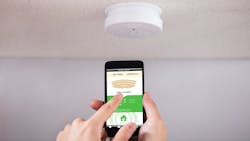Next-gen life safety systems move online with benefits and risks
Life safety systems have traditionally been deployed and managed on isolated, proprietary networks within a building. These systems include heat detectors, fire alarm strobes, integrated fire suppression systems, and water flow sensors. However, on the horizon are a new generation of building safety systems that can be connected, monitored, and managed via an IP-based network. This consolidation of OT systems onto an already consolidating IT/OT network brings both benefits and concerns.
Smart building occupant health and safety technologies are moving toward consolidated networks for several reasons, and strategic owners and IT/OT managers can implement these types of life safety systems reliably and securely.
Benefits: Standards-based network/cabling and ease of monitoring
For many building owners, the biggest downside to traditional life safety systems is that many of the system’s components use proprietary operating systems and communication protocols. Consequently, when an existing platform inevitably needs to be expanded or upgraded, building owners are stuck working with a single technology vendor. Proprietary solutions can lead to hardware, software, and recurring management/support contracts that cost significantly more than they should.
Migrating these systems over to standards-based IP networks opens the door to benefits from both a cost-savings and ease of monitoring and alerting perspective. Cost savings can largely be achieved by leveraging a smart building’s existing IP network infrastructure that supports IT operations within a building or campus. This includes the use of not only network routers and switches, but also existing Category 5e or better network cabling when connecting life safety devices to the IP network.
Options to monitor and manage individual life safety components and platforms will also become more plentiful and flexible thanks to this migration process. These systems will likely natively integrate SNMPv3 standards, for example, allowing for monitoring with the same tools (potentially including AIOps) used to monitor existing network, server, and storage hardware and software. Therefore, operations teams can leverage their monitoring experience to begin monitoring next-gen building safety systems with relatively little effort.
Drawbacks: Network resiliency and cybersecurity threats
Traditional life safety systems and their associated proprietary networks were designed with high levels of resiliency and reliability in mind. As such, existing IP networks must be evaluated to ensure they include similar levels of hardware- and software-based resiliency and redundancy prior to trusting it with the transport of critical health and safety data.
The other major concern when merging health and safety systems onto an IP network deals with cybersecurity threats. Because previous iterations of these systems were proprietary in nature, they were considered a minuscule target for hackers. Additionally, most of these systems were designed to be inaccessible remotely, further limiting risk.
However, now that next-gen life safety systems will soon be operating over TCP/IP networks, which are accessible via the internet, the risk of unauthorized access and remote tampering increases significantly. This uptick must be considered by building owners and their IT/OT staff.
Net effect: Benefits can outweigh drawbacks under certain conditions
While risks in next-gen life safety systems do exist, they can be identified and largely eliminated with proper planning and management. Planning comes in the form of a thorough evaluation of the existing IP network to identify areas where resiliency, redundancy, and cybersecurity should be bolstered. This may include the need to implement active/standby network hardware components, dynamic routing protocols, the integration of layer 4-7 firewalls and micro-segmentation.
Once these security measures are implemented, frequent monitoring and cybersecurity threat assessments should be performed by skilled in-house staff or external consultants to ensure that systems are properly patched and kept protected using a host of recommended network-based security tools and best-practice guidelines. If this can be accomplished, the benefits of next-gen smart building life safety systems will outweigh any drawbacks.
About the Author

Andrew Froehlich
Contributor
As a highly regarded network architect and trusted IT consultant with worldwide contacts, Andrew Froehlich counts over two decades of experience and possesses multiple industry certifications in the field of enterprise networking. Andrew is the founder and president of Colorado-based West Gate Networks, which specializes in enterprise network architectures and data center build-outs. He’s also the founder of an enterprise IT research and analysis firm, InfraMomentum. As the author of two Cisco certification study guides published by Sybex, he is a regular contributor to multiple enterprise IT-related websites and trade journals with insights into rapidly changing developments in the IT industry.
